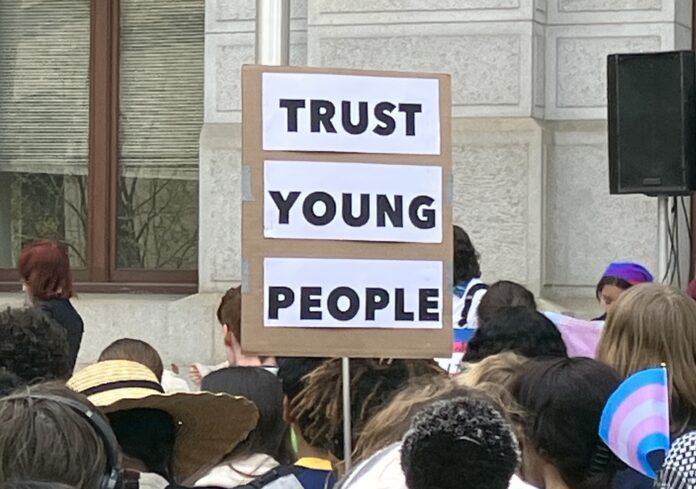The LGBTQ+ youth organization The Trevor Project released the 2023 U.S. National Survey on the Mental Health of LGBTQ Young People, which revealed that 41% of respondents said they seriously considered suicide and 14% of respondents said they attempted suicide in the past year. Composed of responses from 28,0000 LGBTQ youth 13-24 years old, the survey reveals persistently elevated rates of mental health challenges and risk of suicide among queer and trans youth. These high rates of mental health distress among LGBTQ youth are connected to stigma and victimization, the report indicates.
Rates of considered and attempted suicide in the past year were particularly high for trans men and trans women: 56% of trans men and 48% of trans women considered suicide, while 23% of trans men and 16% of trans women attempted suicide. In addition, rates of considered and attempted suicide for LGBTQ youth of color were higher than white LGBTQ youth: 53% of Native/Indigenous LGBTQ youth considered suicide in the last year, as did 47% of Middle Eastern/North African LGBTQ youth, 44% of Black LGBTQ youth, 42% of Hispanic/Latinx LGBTQ youth and 34% of Asian American/Pacific Islander LGBTQ youth.
“This is a public health crisis — and it’s preventable,” Kasey Suffredini, vice president of Advocacy & Government Affairs for The Trevor Project, said in a press release. “Our government must work from the top down to curb risk factors like violence and discrimination and increase access to essential health care, safe schools, and support systems. Yet, far too many lawmakers at the state level are working overtime to push a dangerous political agenda that will jeopardize young lives.”
Not surprisingly, anxiety and depression were rampant among survey respondents; 67% of LGBTQ youth reported that they had symptoms of anxiety and 54% had symptoms of depression. However, 56% of LGBTQ youth said that despite wanting mental healthcare, they were unable to get it for various reasons, including fear of discussing their mental health concerns with another person, reluctance to get parental permission, fear of not being taken seriously, and lack of affordability.
Of the 11% of trans and nonbinary youth who reported that they were taking gender-affirming hormones, 65% of them said that they were somewhat or very concerned about losing access to that kind of gender-affirming healthcare.
A hostile political climate toward LGBTQ youth plays a role in perpetuating their poor mental health, the survey shows. Almost one third of survey respondents said that policies and legislation that target LGBTQ communities were the reason for negatively impacting their mental health most or all of the time. Almost two thirds of LGBTQ youth respondents said that hearing about potential state or local “Don’t Say Gay” laws worsened their mental health, while 79% of respondents said that hearing about potential laws that would prohibit conversion therapy made them feel a little or a lot better.
According to the ACLU, 469 anti-LGBTQ bills have been introduced in state legislatures across the country, the majority of which target trans youth. The Williams Institute reported that as of March 2023, 30 U.S. states have either curbed access to gender-affirming care or are considering passing laws that would do so.
Survey respondents who were victimized due to their sexual orientation or gender identity — including being threatened, harmed, discriminated against or subjected to conversion therapy — attempted suicide in the past year at double the rate than those who were not victimized.
Fifty-three percent of respondents said that they were verbally harassed at school because people thought they were LGBTQ; 32% said that they were prohibited from dressing in a way that correlated with their gender identity or expression; 25% said that they were disciplined for retaliating against bullies; 20% said that they received unwanted sexual contact because of their perceived sexual orientation or gender identity, and 9% said that they were physically attacked because of their LGBTQ identity.
Twenty-seven percent of trans and nonbinary youth reported receiving threats of harm in the past year because of their gender identity, while 18% of LGBTQ youth reported that their sexual orientation was the reason that they received the same treatment in the past year. The survey found discrimination to be high among LGBTQ youth: 64% of trans and nonbinary youth said that they felt discriminated against in the past year because of their gender identity, and 51% of LGBTQ youth reported feeling discriminated against in the past year because of their sexual orientation.
Conversely, the report highlighted that LGBTQ youth who experienced affirming environments at home, school, in community events and digital spaces reported lower rates of attempting suicide than those who did not have access to those spaces. Gender-affirming environments for trans and nonbinary youth correlated with lower rates of attempted suicide. Of the survey respondents, 38% of LGBTQ youth said that they felt like their home was LGBTQ-affirming, and 54% said that they considered their school environment to be affirming. Thirty-five percent of trans and nonbinary youth said that they felt like their home was gender-affirming, and just over half felt like their school was gender-affirming.
To help boost LGBTQ youth mental health, survey respondents said that it is important that people in their lives educate themselves on how to be supportive and accepting, on gender identity and sexual orientation in general, on pronoun use, on creating safe spaces, on the gender binary, on the use of microaggressions, on racism and on intersectionality.
Finally, when asked to describe a world in which LGBTQ people were accepted, some LGBTQ youth responded by saying, “people are able to express themselves and be who they want to be,” “people mind their business,” “no one would have to worry about coming out,” and that they would feel “happier, better, peaceful and safe.”
